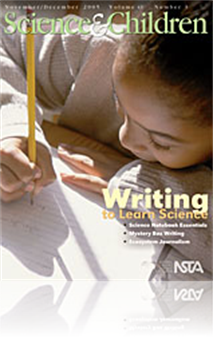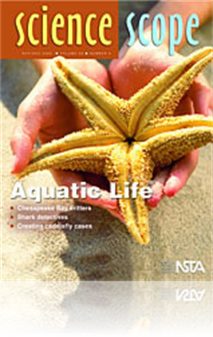All Resources
Journal Article
Five Good Reasons to Use Science Notebooks
Science notebooks are an everyday part of learning in the Tucson (AZ) Unified School District. K-8 schools there have begun using notebooks in conjunction with their kit-based science program. In this article an elementary school shares its journey...
Journal Article
Chesapeake Bay Critters: Up Close and Personal
Shed light on the integral part of the Chesapeake Bay watershed by implementing this hands-on, inquiry- based unit on the Chesapeake Bay watershed. The goals of this unit are to teach students about the bay, its watershed, the organisms that live the...
Journal Article
Commentary: Interdisciplinary Does Not Mean Intimidating
According to the author of this month's Commentary column, "Interdisciplinary units are not superhuman feats, but natural extensions of good teaching practice and conversations among colleagues." She recounts how her thinking in regards to interdisci...
Journal Article
Third-grade students display their understanding of life science concepts by creating an imaginative newspaper. This creative writing project engages students in researching, writing, and editing a newspaper based on a prairie ecosystem....
Journal Article
Science Sampler: Creating caddisfly cases
The larval stage of a northern casemaker caddisfly provides a creative hands-on activity for students while also introducing them to aquatic insect development and adaptations to stream life. This project is an opportunity to study the role of this i...
Journal Article
Exploring New Environments, a half-day workshop developed by the University of North Carolina at Chapel Hill's DESTINY Traveling Science Learning Program, takes an interdisciplinary approach to teacher professional development. This model was created...
Journal Article
Favorite Demonstration: MOS -- The Critical Elements of Doing Effective Classroom Demonstrations
There is a wealth of evidence showing that students can remember many of their science class demonstrations for countless years. This is a good testimony to the emotional impact of demonstrations. One way to make them into an effective teaching str...
Journal Article
Methods and Strategies: Journals of Discovery
Integrated science journals provide educators with valuable insight into teaching. They allow students to reflect on how engaged they were in learning about a particular topic while also providing information about how successful the teacher was in ...
Journal Article
Society for College Science Teachers: Is Academic Freedom a Threat to Teaching Introductory Science?
As academics we value different viewpoints, the right and need to pursue scholarly interests, and the importance of discussing controversial topics as a means of engaging students, promoting critical thinking, and helping students mature intellectual...
Journal Article
Editor's Note (November/December 2005)
Scientists write in many ways as they develop and share what they do. It only makes sense that our students do as well. This issue presents ideas for using writing to create purpose in science class....
Journal Article
Tried and True: It's a gas! An exploration of the physical nature of gases
Gases present something of a paradox for the casual observer--they are everywhere and yet, it remains difficult to see them anywhere. This instructional sequence engages middle school students in the inquiry process, enabling them to develop more rob...
Journal Article
Making the Grounds of Scientific Inquiry Visible in the Classroom
The ability to formulate questions is a critical skill that forms the basis of scientific inquiry. Questioning is indeed robustly rooted in children's everyday ways of thinking about the world, but serious classroom support is required if these child...
Journal Article
The ESA21 Project: A Model for Civic Engagement
Making the content of a course interesting to students can be quite a challenge for an instructor. Making the content of a required general education science course interesting to nonscience majors can be near to impossible. A lack of interest in a s...
Journal Article
Yikes! There is fungus among us! Your middle school students will enjoy this role-playing simulation that's designed to help teach them about the typical lifecycle of a fungus. Students assume the roles of fungi, spores, living and dead organisms, ba...
Journal Article
Changing the Learning Environment in Large General Education Astronomy Classes
The gradual, ongoing transformation of a large general education astronomy class is presented. Emphasis is on student reaction to and academic impact of changes in the teaching/learning environment introduced over a five-year period. In-class, cooper...






